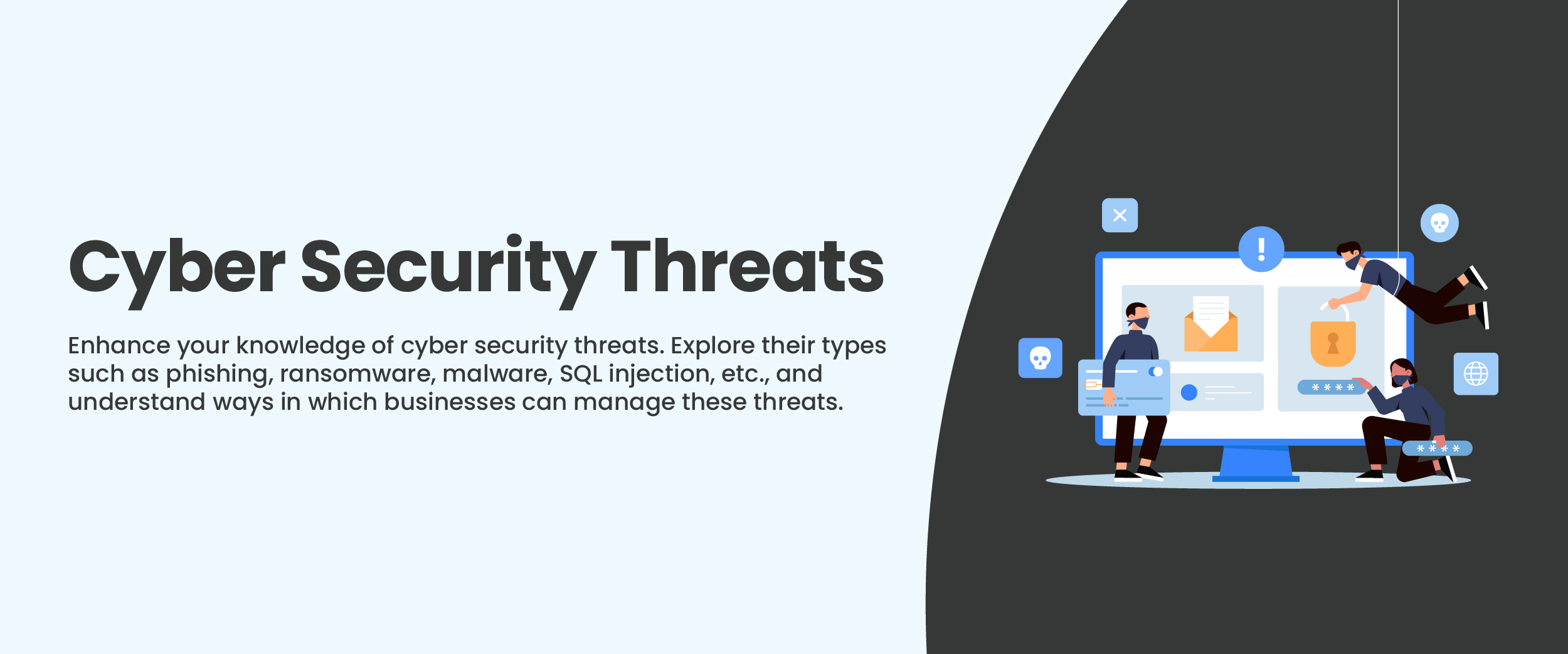Cyber Security Threats: Explore the Types & How To Prevent Them
Today we greatly rely on the digital world for everything from communication to banking to social media and online shopping. However, a wide range of cyber security threats have also emerged as a result of our increasing reliance on technology. Malicious actors, such as hackers and cybercriminals, are always coming up with new ways to attack weaknesses in our digital infrastructure. In this blog, we’ll examine what are threats in cybersecurity, and the most significant security threats, and guide how to protect your data and yourself.
What is a Threat in Cybersecurity?
Any possible risk or hazard offered by hostile individuals or events, such as cyberattacks, malware, hacking attempts, or vulnerabilities, is referred to as a threat in cybersecurity. It involves activities or circumstances that can jeopardize the availability, confidentiality, or integrity of digital systems and sensitive data. To learn more about this consider taking an online course on ethical hacking.
Here is the list of the various types of security threats:
Phishing Attacks
Phishing is a method used by online criminals to trick people into providing personal information by using phony emails, messages, or websites that appear to be from well-known companies.
How Phishing Attacks Work?
Here is how phishing attacks work:
- Phishing: Phishing is the practice of impersonating well-known firms and sending attractive emails to victims to gain their confidence.
- Urgency and Fear: Create a sense of urgency and dread to persuade customers to react swiftly.
- Deceptive URLs: Links that direct consumers to malicious websites by containing minor typographical mistakes.
- Fake Websites: Create fraudulent websites that appear to be authentic to deceive customers into providing sensitive information.
- Social Engineering: Social engineering is the use of human emotions such as curiosity, greed, or fear to make individuals more gullible.
Preventing Phishing Attacks
Here is how to prevent the attacks:
- Observance: Be wary of any unsolicited emails, texts, or conversations, particularly those that demand sensitive information or threaten negative outcomes if you don’t respond.
- Check Senders: Carefully review email sender names to check for any odd or misspelled domains. To confirm the validity of the communication, get in touch with the alleged sender using authorized methods.
- Hover Before Clicking: Before clicking on links in emails, move the mouse pointer over them to see the URL. Make sure they point to trustworthy websites.
- Secure Websites: Using HTTPS, which encrypts data transfer and guards against any eavesdropping, access sensitive websites securely.
- Security Software: Use renowned antivirus and anti-malware programs since they can identify and stop phishing attempts.
1
10 Cyber Security Applications – The Complete Guide
Today, organizations are shifting to cloud systems, making them more vulnerable to cyber-attacks. Therefore, there is a growing need to implement cybersecurity measures to avoid financial and reputational losses.
According to Statista, in 2027, the cyber security market will grow to 266.2 billion dollars. This has led to an increase in demand for cybersecurity experts worldwide. This blog will cover information about important cyber security applications and why having a robust cybersecurity system is important.
Top 10 Cyber Security Applications
To protect your organization’s system and data, you must have a good understanding of cybersecurity tools. You can also take an online ethical hacking course to learn about basic vulnerabilities in cyber security. Now, let’s take a look at some of the cybersecurity applications:
1. Network Security
To ensure the security of the organization’s system, one has to continuously monitor the network and look for any signs of intrusion or harmful behavior. It is often used with other security tools, such as antivirus software, IDPs, and firewalls.
2. Monitoring the Bots
Nowadays, many attackers and hackers use bots to create device traffic and crash the server. However, cybersecurity helps identify fake users/bots. This ensures that the normal user experience is not affected.
3. Antivirus and Antimalware
Another vital application of cybersecurity is to develop antimalware and antivirus software to prevent digital attacks on the system. It also helps maintain firewall systems and network security for all the devices connected to the network.
4. Threat Management Systems
Hackers use vulnerabilities to attack the system. Cybersecurity optimizes these defects and vulnerabilities automatically, effectively controlling vulnerability issues.
5. Critical Systems
Cybersecurity helps in dealing with critical issue attacks. These attacks are carried out on large servers connected to wide-area networks. Cybersecurity ensures that high safety protocols are maintained and the users comply with the security measures to protect the devices. It monitors the applications and regularly checks the network and servers’ safety.
6. Identification and Access Control
The organization’s management regulates who gets access to the networks, computer systems, and data. Cybersecurity identifies the users and executes the access control. It uses RBAC, role-based access, to limit access to particular system components.
7. Software Security
Software security protects the applications crucial to the organization’s operation. It consists of controls such as application whitelisting and code signing. Cybersecurity also helps in unifying the security rules with multifactor authentication and file-sharing.
8. Risk Management
Cybersecurity covers risk management, data integrity, security data integrity, awareness training, and risk analysis. These are the essential risk management components of cybersecurity.
9. Data Recovery
In case of data loss, data recovery enables businesses to continue working. With the help of data backup, cyber security offers techniques and models that help the organization manage severe data loss. Therefore, cyber security applications also ensure the continuity of the business.
10. Physical Security
Physical security includes surveillance systems, detection systems, data-destruction systems, alarms, etc. It ensures that the IT infrastructure of the organization is secured.


Malware Infections
Malware is malicious software designed by cyber criminals to enter networks and steal data, posing a major risk to both consumers and organizations. Understanding its forms and routes is critical for protection.
Types of Malware
Here are the types of malware:
- Viruses: When a healthy file or application is executed, the virus attaches itself to it and spreads. Because viruses propagate so fast, other files and computers might get infected.
- Trojans: Trojans, named after a well-known Greek myth, are harmful programs or files that masquerade as innocuous. They are widely used as backdoors, allowing attackers to gain unauthorized access to a system.
- Worms: Worms are self-replicating malware that spreads across networks without human intervention. They have the potential to cause significant harm through resource usage and network saturation.
- Ransomware: Ransomware encrypts a victim’s data and prohibits access to it unless the attacker is paid a ransom. It has become one of the viral kinds with the highest monetary rewards.
- Spyware: Spyware secretly watches over and gathers data from a user’s device without their knowledge. It can steal sensitive data, track surfing patterns, and record keystrokes.
- Adware: On infected devices, adware shows annoying pop-ups and adverts. Although it isn’t usually dangerous, it can annoy users and hinder system efficiency.
- Rootkits: Rootkits are clever pieces of malware intended to take over a system administratively while evading detection by more conventional security procedures.
Methods of Infection
Here are the methods of infection:
- Email Attachments: Infected email attachments are a common way for malware to spread. When users open these attachments, the virus is unintentionally activated.
- Drive-by Downloads: When a user visits a hacked website, cybercriminals leverage flaws in web browsers or plugins to trigger the automated download of malware.
- Infected External Devices: Malware can enter a computer using infected USB devices, external hard drives, or other portable media.
- Malicious Links: Opening malicious links found in emails, social media posts, or messaging applications can infect a device with malware.
Preventing Malware Infections
Here are the steps to prevent malware infections:
- Keep Software Updated: To address known vulnerabilities, regularly update operating systems, applications, and antivirus software.
- Caution: Use caution when opening attachments or clicking links in emails from untrustworthy or suspicious sources.
- Activate Firewall: Use a firewall to prevent unauthorized connections by monitoring incoming and outgoing network traffic.
- Install Antivirus and Anti-malware Software: Use this program to detect and remove undesirable applications.
- Backup Your Data: To mitigate the consequences of ransomware attacks, back up your critical data to a secure external storage location regularly.
Distributed Denial of Service (DDoS) Attacks
The resources of a target are overloaded by a DDoS attack, making them unavailable to authorized users. Compared to DoS assaults, it uses several sources, making mitigation difficult.
How DDoS Attacks Work?
Here is how the attacks work:
- Botnets: A network of hacked devices, or “botnet,” is frequently used in DDoS assaults. Numerous IoT gadgets, cellphones, and laptops are infected by cybercriminals with malware, giving them control without the owners’ awareness. They are then told to simultaneously deliver a flood of traffic to the target server using these “bots” or “zombies,” as they are also known.
- Traffic Overload: The target’s infrastructure is overwhelmed by the sheer amount of incoming requests, devouring its bandwidth, processing power, and memory. Genuine users trying to use the service, as a result, encounter poor response times or total unavailability.
Different Types of DDoS Attacks
Based on the attack vectors used, DDoS attacks may be divided into several different categories. These consist of:
- Volumetric Attacks: Volumetric attacks include DNS amplification attacks and UDP reflection/amplification attacks, which overwhelm the victim with a large amount of traffic.
- TCP State-Exhaustion Attacks: Similar to SYN floods, these attacks leverage the stateful nature of TCP (Transmission Control Protocol) connections to exhaust server resources.
- Application Layer Attacks: These attacks use application layer flaws to overwhelm certain services (for example, HTTP floods).
Preventing and Mitigating DDoS Attacks
Here are the steps:
- DDoS Protection Services: Utilizing specialist DDoS protection services, such as on-premises equipment or cloud-based solutions, can assist in the detection and mitigation of assaults by filtering out malicious data.
- Traffic Analysis and Anomaly Detection: Implement traffic analysis techniques to identify anomalous patterns and behaviors, which can assist in distinguishing between genuine traffic and attack traffic.
- Load Balancing: Distribute incoming traffic among several servers using load balancing to ensure that no one server is overloaded during an assault.
- BGP Black Hole Filtering: Internet service providers (ISPs) can stop DDoS traffic before it reaches the target by using BGP black hole filtering (Border Gateway Protocol).
- Web Application Firewalls (WAF): By filtering and monitoring HTTP traffic, WAFs may thwart assaults on the application layer.
Man-in-the-Middle (MITM) Attacks
Communication between parties that believe they are directly conversing is intercepted and altered during an MITM attack. The assailant listens in, gathers information, and could even alter it.
How do MITM Attacks work?
Here is how MITM attacks work:
- Interception: By taking advantage of weaknesses in the communication route, the attacker takes up position between the sender and the receiver. Techniques like ARP spoofing, DNS spoofing, or exploited Wi-Fi networks can be used to do this.
- Eavesdropping: If the communication channel is intercepted, the attacker can listen in on the entire discussion and get private information like login information, financial information, or message content.
- Data Manipulation: The attacker may occasionally actively change the data being sent between the parties. They may, for instance, modify the subject line of an email, or the location of a financial transaction, or add harmful malware to software upgrades.
- Transaction Tampering: During an MITM attack on a financial transaction, the attacker can change the transaction’s specifics, including the recipient’s account number or the transaction’s size, rerouting money to their accounts.
Common Scenarios of MITM Attacks
Here are some of the common scenarios :
- Wi-Fi Networks: To trick users into connecting to them, hackers may construct phony Wi-Fi hotspots with names that seem similar to real ones. Once connected, the attacker can intercept data sent over the network.
- Unsecured Websites: Unencrypted (HTTPS) websites can be used by attackers to intercept user and website interactions and potentially acquire login credentials or other sensitive information.
- Untrusted Networks: If public networks, such as those found in coffee shops or airports, are not adequately secured, attackers may intercept data transferred over them and utilize it in MITM attacks.
Preventing MITM Attacks
Here is how you can prevent:
- Encryption: To encrypt data during transmission, use secure communication protocols like HTTPS (HTTP over SSL/TLS) for websites and VPNs (Virtual Private Networks) for secure distant connections.
- Digital Certificates: Validate website digital certificates to make sure you are connecting to reliable and trustworthy servers.
- Public Wi-Fi Caution: Use a VPN to access vital services instead of sending sensitive data over open Wi-Fi networks.
- Two-Factor Authentication (2FA): Enable two-factor authentication (2FA) wherever you can strengthen the security of your online accounts.
Social Engineering
Instead of focusing on technology faults, cybercriminals use social engineering to exploit people’s psyches and trusts to steal data, get unauthorized access, or conduct fraud.
Common Techniques of Social Engineering
Here are the common techniques:
- Phishing: When cybercriminals deceive their victims, they may steal their personal information or carry out destructive deeds.
- Pretexting: To obtain sensitive information from victims, attackers fabricate circumstances and pose as reliable individuals.
- Baiting: Attackers lure victims with alluring offers so they would interact with harmful content, which gives them access.
- Quid Pro Quo: Attackers trick victims into disclosing private information or offering support by impersonating helpful IT workers.
- Tailgating: Attackers can circumvent physical security measures to enter restricted locations by physically pursuing authorized persons.
Preventing Social Engineering Attacks
Here is how you can prevent these attacks:
- Education and Awareness: Raise people’s awareness of the various social engineering strategies and teach them how to spot suspicious conversations or situations.
- Verification: Before granting access or supplying any data, make sure that the people making the requests are who they say they are.
- Security Rules: To protect against social engineering attacks, implement strict security rules and processes. This entails minimizing the quantity of private information that is disclosed in public and regularly undertaking security awareness training.
- Two-Factor Authentication (2FA): Enable two-factor authentication (2FA) wherever you can since it offers an additional layer of protection and makes it harder for attackers to get unwanted access.
- Trust but Verify: Encourage a healthy skepticism and a “trust but verify” attitude, where people exercise caution even when interacting with sources that seem reliable.
Conclusion
The advancement of technology has increased risks to the security of our digital lives. To safeguard ourselves, our businesses, and sensitive information, we must be aware of these threats and take preventative precautions. To fortify our digital defenses against the ever-changing spectrum of cybersecurity threats, we must be vigilant, practice good cyber hygiene, and build a security-oriented culture. It is essential to underline that attention is critical in the field of cybersecurity.







